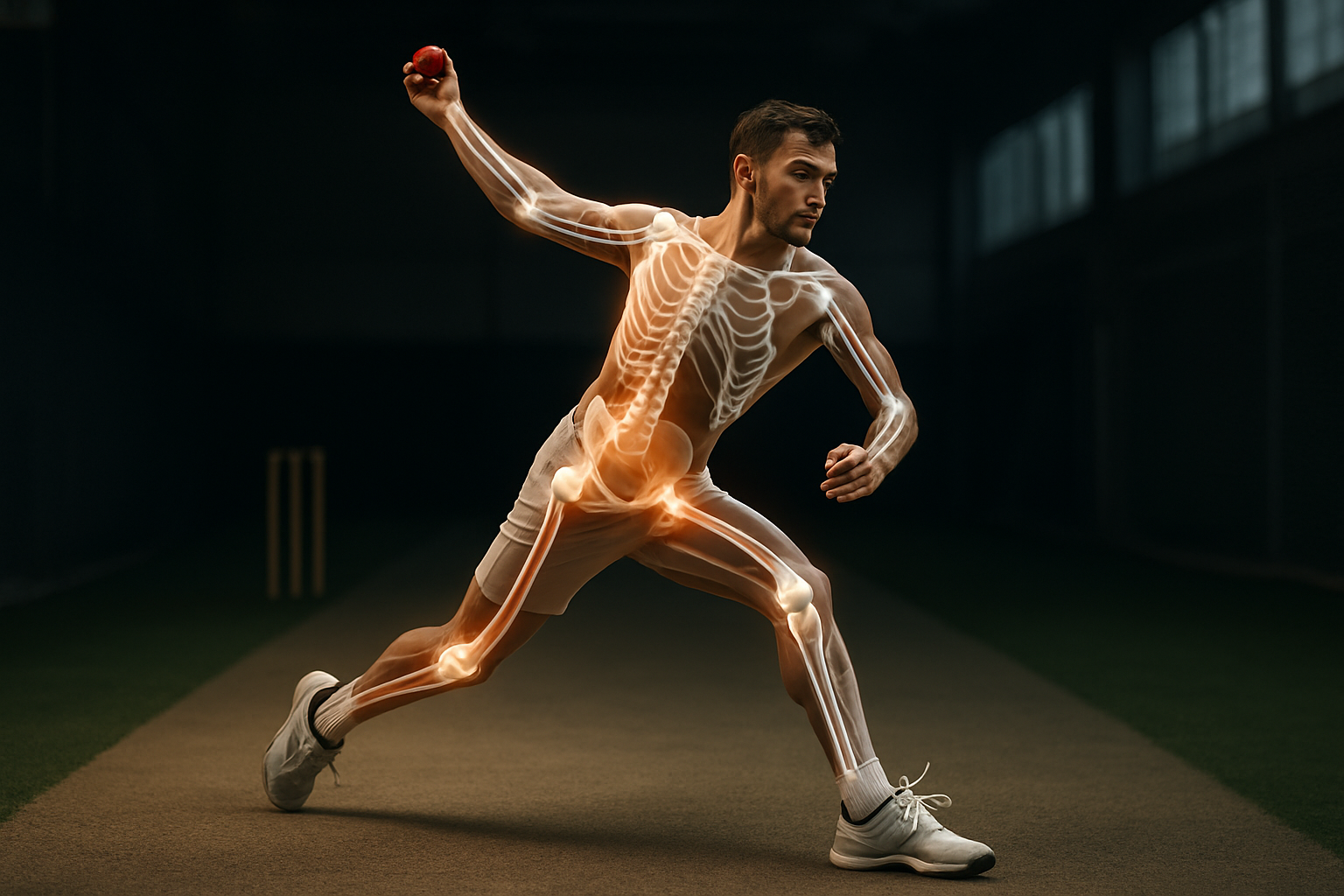Biomechanics of Cricket Fast Bowling: Unveiling the Perfect Pace
The thunderous approach, the rhythmic leap, and the explosive release – fast bowling in cricket is a spectacle that captivates audiences worldwide. But beneath the surface of this awe-inspiring display lies a complex interplay of biomechanical principles that separates the good from the great. This exploration delves into the intricate science behind cricket's most dynamic skill, uncovering the secrets that propel leather spheres at blistering speeds.

The Biomechanical Blueprint of Fast Bowling
At its core, fast bowling is a kinetic chain of events that transfers energy from the ground through the bowler’s body and into the cricket ball. This process begins with the run-up, a critical phase that sets the foundation for the entire delivery. The optimal run-up speed varies among bowlers but typically falls between 17-21 km/h. This speed allows for maximum momentum generation without compromising control.
As the bowler approaches the crease, the body begins to coil like a spring, storing potential energy. The back foot contact marks the start of the delivery stride, where ground reaction forces play a crucial role. Studies have shown that elite fast bowlers can generate vertical ground reaction forces of up to 6-8 times their body weight during this phase. This force is then channeled through the legs, trunk, and arms in a whip-like motion.
The front foot contact is another critical moment, acting as a fulcrum around which the body pivots. Researchers have identified that a slightly flexed front knee at this point can reduce the risk of injury while maintaining bowling speed. The trunk then rapidly rotates and extends, with angular velocities reaching up to 40 degrees per second in top performers.
The Art of Energy Transfer
The secret to generating high ball speeds lies in the efficient transfer of energy through the kinetic chain. This process is akin to a whip cracking, with each segment of the body accelerating and then decelerating in sequence. The hips initiate the motion, followed by the trunk, shoulder, elbow, and finally, the wrist.
Elite fast bowlers exhibit a phenomenon known as proximal-to-distal sequencing. This means that the larger, more proximal body segments (like the trunk) reach their peak angular velocity before the smaller, distal segments (like the wrist). This sequence allows for optimal energy transfer and results in higher ball release speeds.
The non-bowling arm also plays a crucial role in this energy transfer. As it is pulled down and across the body, it creates a counterrotation that accelerates the bowling arm. Studies have shown that proper use of the non-bowling arm can contribute up to 13% of the final ball speed.
Biomechanical Factors Influencing Ball Speed
Several key biomechanical factors have been identified as crucial for achieving high bowling speeds:
- Front knee angle: A slightly flexed front knee (around 170-175 degrees) at front foot contact has been associated with higher ball speeds and reduced injury risk.
- Trunk lean: A forward trunk lean of approximately 20 degrees at ball release has been linked to faster deliveries.
- Shoulder counter-rotation: The ability to rotate the shoulders away from the target before initiating the bowling action can increase the range of motion and potential energy storage.
- Hip-shoulder separation: A greater angle between the hip and shoulder alignment during the delivery stride correlates with higher ball speeds.
- Elbow extension velocity: Rapid extension of the elbow in the final moments before ball release contributes significantly to ball speed.
By optimizing these factors, bowlers can potentially increase their bowling speed without necessarily increasing their overall physical effort.
The Role of Lower Body Mechanics
While much attention is often given to the upper body in fast bowling, the lower body plays an equally crucial role. The legs act as the power generators, providing the initial burst of energy that propels the entire action.
During the run-up and delivery stride, fast bowlers exhibit high levels of muscle activation in the quadriceps, hamstrings, and calf muscles. The gluteal muscles are particularly important, as they drive hip extension and contribute to the forward momentum of the body.
The braking force of the front leg upon landing is a critical factor in converting the horizontal momentum of the run-up into vertical lift and rotational energy. Elite bowlers can generate braking forces of up to 7 times their body weight, which is then transferred up through the kinetic chain.
Upper Body Dynamics and Ball Release
As the energy travels up the kinetic chain, the upper body becomes the focal point of the bowling action. The rapid rotation of the trunk, which can reach angular velocities of up to 1500 degrees per second, is a key contributor to ball speed.
The bowling arm follows a complex path, initially lagging behind the trunk rotation before rapidly accelerating. This delay in arm acceleration, known as the “lag” phase, allows for greater energy storage and subsequent release. The shoulder joint experiences extreme forces during this process, with internal rotation velocities reaching up to 7000 degrees per second in some elite bowlers.
The final link in the chain is the wrist snap, which occurs just before ball release. This rapid flexion of the wrist can add an extra 5-10% to the final ball speed and is often what separates the fastest bowlers from their peers.
Biomechanical Variations Among Fast Bowlers
While there are general principles that apply to all fast bowlers, it’s important to note that individual variations exist. Factors such as height, muscle composition, and joint flexibility can influence a bowler’s optimal biomechanics.
For example, taller bowlers often benefit from a higher point of release, which can create a steeper bounce angle and make it more difficult for batsmen to judge the ball’s trajectory. Conversely, shorter bowlers may rely more on rapid arm rotation and wrist snap to generate speed.
Some bowlers utilize a more side-on technique, which involves greater shoulder counter-rotation and can potentially generate more pace. Others prefer a front-on approach, which may offer better control and consistency. The key is for each bowler to find the technique that best suits their physical attributes and allows for maximum efficiency in energy transfer.
The Impact of Fatigue on Bowling Biomechanics
Fast bowling is an incredibly demanding activity, and fatigue can have a significant impact on biomechanics. As bowlers tire, several changes in their technique are commonly observed:
- Decreased run-up speed
- Reduced front knee flexion at front foot contact
- Lower trunk rotation velocity
- Decreased shoulder internal rotation velocity
- Reduced ball release speed
These changes not only affect performance but can also increase the risk of injury. Managing workload and maintaining proper technique even when fatigued is crucial for fast bowlers’ longevity and success.
Injury Prevention Through Biomechanical Analysis
The extreme forces involved in fast bowling make it one of the most injury-prone activities in cricket. Common injuries include stress fractures of the lower back, shoulder impingement, and knee ligament damage. However, understanding the biomechanics of bowling can help in developing strategies to mitigate these risks.
For instance, maintaining a front knee angle between 170-175 degrees at front foot contact has been shown to reduce the risk of lower back injuries. Similarly, proper alignment of the trunk and lower body during the delivery stride can minimize stress on the shoulder joint.
Biomechanical analysis using high-speed cameras and motion capture technology is now a common practice in elite cricket. This allows coaches and sports scientists to identify potential injury risks and make technique adjustments before problems arise.
Training Implications of Bowling Biomechanics
Understanding the biomechanics of fast bowling has significant implications for training methodologies. Rather than focusing solely on building strength and endurance, modern training programs incorporate exercises that enhance the specific movements involved in bowling.
Plyometric exercises, for example, can improve the explosive power needed for the delivery stride. Rotational core exercises help develop the trunk strength and flexibility required for generating high angular velocities. Specific shoulder strengthening programs are designed to cope with the extreme forces experienced during the bowling action.
Moreover, technique drills are now more focused on optimizing energy transfer through the kinetic chain. Bowlers may practice with sensors attached to their bodies to provide real-time feedback on their biomechanics, allowing for immediate adjustments and reinforcement of proper technique.
The Future of Fast Bowling Biomechanics
As technology continues to advance, our understanding of fast bowling biomechanics is likely to deepen further. Wearable sensors and artificial intelligence algorithms may soon provide instant analysis and technique recommendations during training and matches.
Virtual reality simulations could allow bowlers to practice their technique in a controlled environment, minimizing physical strain while maximizing skill development. Genetic analysis may even play a role in identifying individuals with physical attributes particularly suited to fast bowling, allowing for early specialization and targeted training.
However, as we push the boundaries of human performance, ethical considerations will become increasingly important. Balancing the pursuit of speed with player safety and the integrity of the sport will be crucial challenges for cricket administrators and scientists alike.
Conclusion: The Ongoing Evolution of Fast Bowling
The biomechanics of fast bowling represent a fascinating intersection of physics, physiology, and sport. As our understanding of these principles grows, so too does the potential for bowlers to push the limits of speed and accuracy.
Yet, for all our scientific advancements, fast bowling remains as much an art as it is a science. The subtle variations in technique, the psychological aspects of performance, and the sheer thrill of a perfectly executed delivery ensure that fast bowling will continue to captivate cricket fans for generations to come.
As we look to the future, it’s clear that the evolution of fast bowling is far from over. With each new discovery in biomechanics, with each technological innovation, and with each exceptional performer who pushes the boundaries, we inch closer to unlocking the full potential of this remarkable skill. The quest for the perfect pace continues, driven by the relentless pursuit of excellence that defines the spirit of cricket itself.




